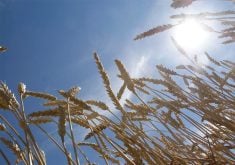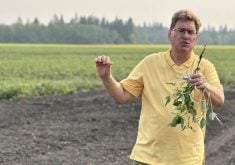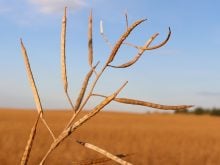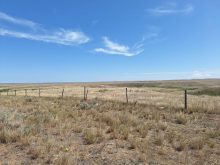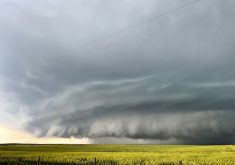One’s view of the weather is certainly not universal across all demographics, says David Spence, who retired as chief meteorologist at CTV Calgary after a more than 40 year career in broadcasting.
“The one thing I’ve learned is one person’s good weather is another person’s bad weather. On television, I’m talking to a mainly urban audience. City people love sunshine. But I would never, ever go on and say it’s going to be a nice day because it’s sunny,” Spence said at the Farming Smarter Conference and Trade Show in Lethbridge in early February.
“To the people taking their families to the park, it is a beautiful day. But, it’s not a beautiful day (for those) who don’t know when the next drop of rain is coming. It’s not a nice day for them. So, I learned not to use adjectives or judge the weather; just present it, just tell the facts.”
Read Also

Huge Black Sea flax crop to provide stiff competition
Russia and Kazakhstan harvested huge flax crops and will be providing stiff competition in China and the EU.
For Spence, the weather was not just maps and charts — it was also about connecting with his community and guiding them through those literal and figurative storms he reported on, earning respect as a trusted voice in the process.
“You are part scientist and part therapist,” said Spence.
Drought has always been a problem in southern Alberta and the Prairies since recorded time.
Spence recalled his agriculture ancestral background, coming from Scotland a few generations ago with the promise of free land in an area north of Edmonton.

With no running water or electricity, it was an earth hut where the winters were as cold as they are today. The promise of lush farmland was not so lush as advertised. Instead, it was dry grassland, a dry climate and disappointment.
“Alberta was as dry then as it is now. The climate may be changing, but the drought is not because of climate change. It has been this way all along and will likely be this way in the future. It’s not permanent, but it is persistent. It goes away and it comes back, it goes and it comes back.”
Last spring was a scary time because there wasn’t much rain or snow to fall back on and the reservoirs were dry. The drought did not necessarily disappear when the spring rain came, but some of the dryness did.
“There was enough rain to get the growing season underway but not enough to erase the long-term drought. In May, there was plenty of rain in eastern Alberta, which received 200 per cent of their normal rainfall in the spring of 2024. Was it enough? Yes and no,” said Spence.
“It certainly helped the planting germination, but the rain mainly fell in the eastern regions, so it didn’t really help anywhere west of Highway 2.”
Once the rain was done, it got dry again all across central Alberta and the rest of the province. It presented challenges for crop maturation and pasture vitality and necessitated careful water management to get crops to full growth for harvest.
In the fall, precipitation deficits continued in central Alberta despite some areas receiving above-average precipitation. Producers still face drought heading into the next growing season, and it was hoped La Nina would help with that.
“The prospect of a La Nina winter has given us some hope and given us some optimism,” said Spence.
During La Nina events, trade winds are even stronger than usual, pushing more warm water toward Asia. Off the west coast of the Americas, upwelling increases, bringing cold, nutrient-rich water to the surface.
These cold waters in the Pacific push the jet stream northward. This tends to lead to drought in the southern U.S. but heavy rain and flooding in the Pacific Northwest and Canada. Unfortunately, the early parts of this critical time have been disappointing.
“La Nina hasn’t really played out that well. It has been pretty fairly warm up until February. But, we are entering what is expected as the peak of this expected La Nina in February, March and April. It has got colder, but we are still waiting for more snowfall. Will it come? It would be wonderful if it would,” said Spence.
Just as important as the snow is how it disappears. If the region receives plenty of snow in March and April but then a hot sunny late April, May and June, that will negate some of the gains.
“It still goes into the sky and evaporates and doesn’t get into the ground like we need it. We need a cool spring, we need a cloudy spring so more of that snow seeps into the ground and be beneficial to us than evaporate into the sky. It is a perennial problem in southern Alberta because we have a very sunny, dry climate. With the dry air, it wants to absorb as much moisture as possible,” said Spence.
Late last year, Spence participated in a webinar featuring approximately 100 farmers and top meteorologists and focusing on drought with concerning trends.
“Drought begets drought. Droughts do not break easily, especially in the west,” said Spence, adding droughts in the west can last five to six years opposed to droughts in the U.S. Midwest, which is eight to nine months.
Drought is the result of dry weather that persists because of high atmospheric pressure. High pressure not only gives dry weather and sunny skies but blocks storm systems from coming in. It results in droughts that don’t break gently.
“it doesn’t end when we get gradual increases in rainfall. It ends when big storms come in,” said Spence.
One silver lining with drought is it can have its advantages, as long as it’s not happening to you.
“(Farmers) love drought when it’s happening somewhere else. If it is happening somewhere else, chances are it’s not happening here. When the West is in a drought, the central part of Canada and the Midwest usually is not. When the central part of Canada and the Midwest are in a drought, we are not because of the jet stream and the atmospheric patterns going on,” said Spence.
“So farmers love drought as long as they are getting it somewhere else. It forces commodity prices up and everyone in the non-drought areas will benefit from that.”
Spence still does some weather forecasting for Rural Roots Canada, where he can concentrate his reports on the ag industry.
He said what happens this growing season is going to depend on what happens after March 1.
“The moisture you get over the winter is good, but it’s what falls after March 1. This part of the world, March, April, May, June, that’s the rainy season. If we get a lot of precipitation over the next few months, we will be OK. It’s also how it disappears, whether it evaporates or soaks into the ground, which depends on weather patterns as well.”
While predicting weather is nearly impossible past a few days, meteorologists have a number of tools to help them look into the future.
Spence gave his audience a glimpse into the next few months using the Coupled Forecast System (CFS).
The system runs conditions in the oceans and in the atmosphere through several programs and algorithms. Approximately 20 inputs are run through into the model.
March is looking more promising for moisture than February, according to the model for British Columbia and the mountain areas of Alberta and Eastern Canada.
For April, Alberta, Saskatchewan and Manitoba are expected to receive above average levels of precipitation.
The model showed continued good news for May, which is usually the start of the dry season, with bonus moisture.
It showed significant moisture for Saskatchewan and Manitoba, with Alberta still showing strong levels of precipitation. For June, it looks like southwestern Alberta will experience drought again.
“What you are hoping for is the moisture that comes through from the spring soaks into the ground rather than evaporate by a bunch of sunshine, which we expect in June and July,” said Spence.
“It’s not a lost cause, looks like we could get some moisture (in the spring) and let’s hope that’s right and it all plays out like it’s shown, getting some good moisture again this year for seeding, planting, germination.”
Spence does his weekly forecasts for ruralrootscanada.com every Monday for a seven-day forecast across the Prairies, which is updated on Thursdays.
“While we cannot control the weather, we can control how we respond to the weather. By continuing the expertise of meteorology with the ingenuity of agriculture, we can work together to provide productive results for our community.”





